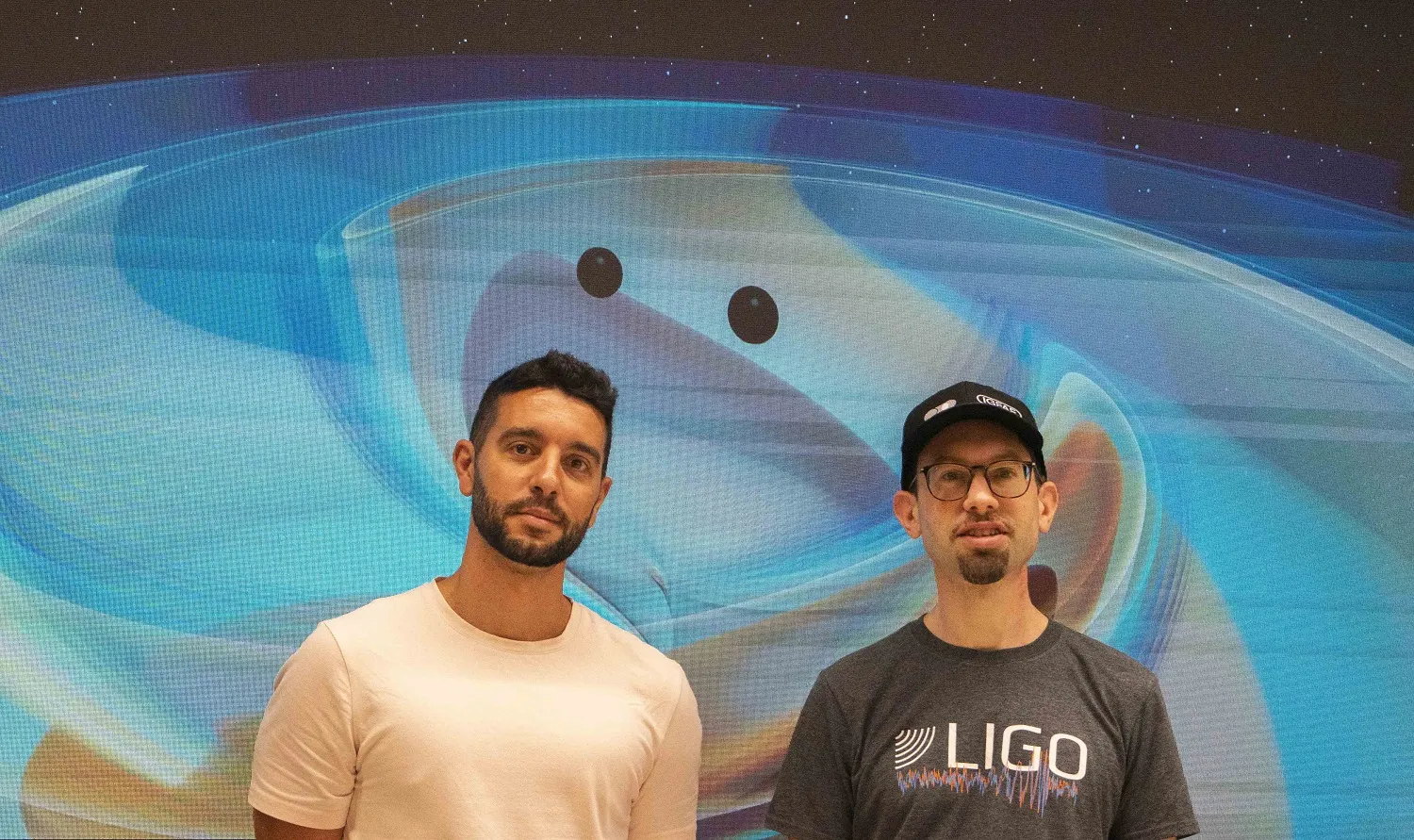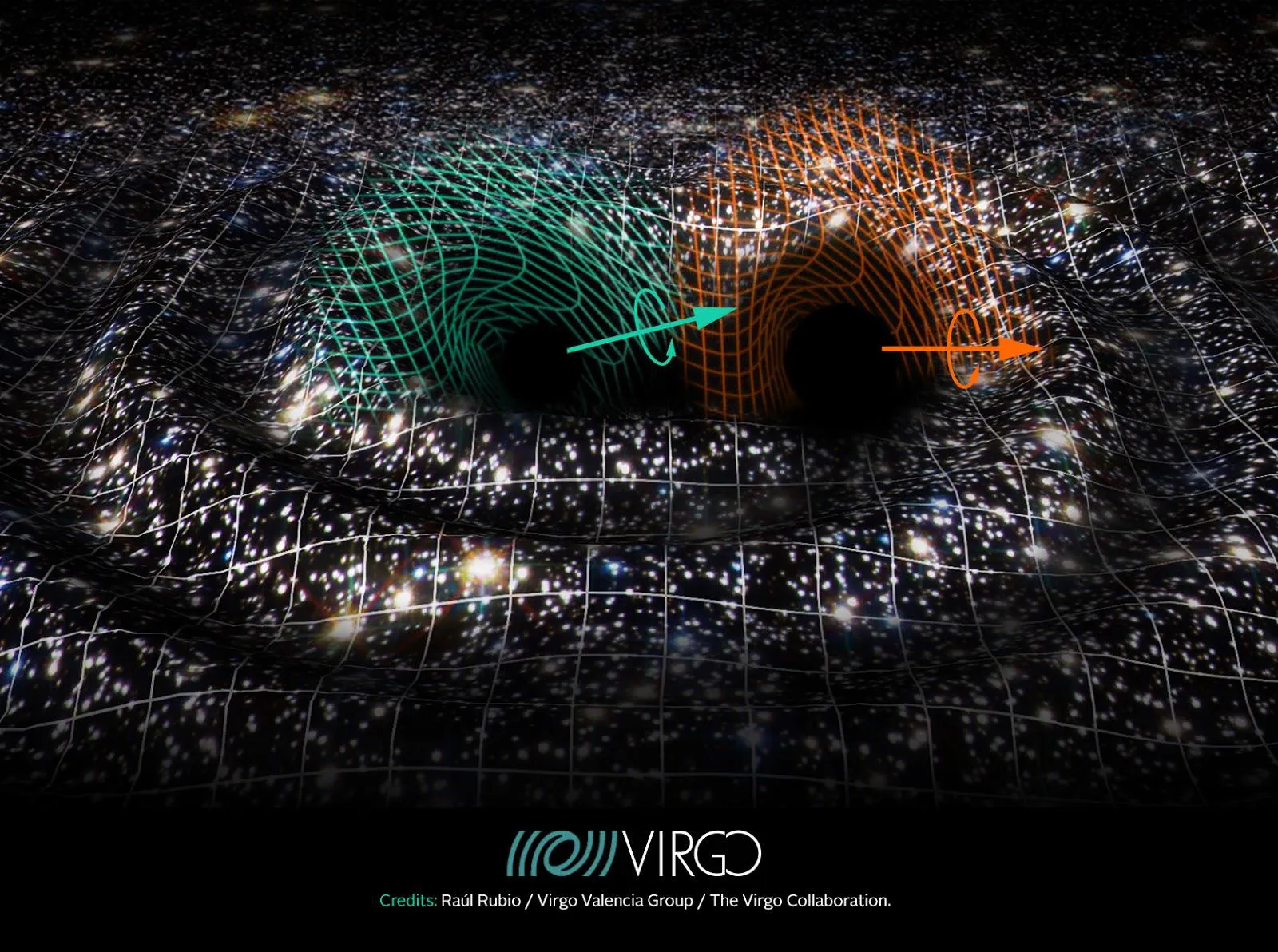Buracos negros chocando no límite da relatividade de Einstein: un achado de récord co protagonismo do IGFAE



02.09.2020

LIGO e Virgo anuncian hoxe a detección dun sistema binario extraordinariamente masivo fusionándose: dous buracos negros de 66 e 85 masas solares, que xeraron un buraco negro final de ao redor de 142 masas solares. O buraco negro remanente é o máis masivo xamais detectado con ondas gravitacionais. Sitúase nun rango de masas no que un buraco negro non foi observado nunca antes, nin a través de ondas gravitacionais nin con observacións electromagnéticas, e podería axudar a explicar a formación de buracos negros supermasivos. Ademais, os dous buracos negros iniciais, se xurdiron do colapso de estrelas, sitúanse nun rango de masas no cal a súa presenza considérase, en teoría, imposible, e podería por tanto axudar a mellorar a nosa comprensión sobre as etapas finais da vida das estrelas masivas.
A comunidade científica das colaboracións internacionais do detector Advanced Virgo no Observatorio Gravitacional Europeo (EGO, das súas siglas en inglés), en Italia, e dos dous detectores Advanced LIGO, en EEUU, anunciaron a detección dun buraco negro de ao redor 142 masas solares, resultado final da fusión de dous buracos negros de 66 e 85 masas solares. Tanto a compoñente primaria como o remanente sitúanse nun rango de masas que non foi observado nunca antes, nin a través de ondas gravitacionais nin con observacións electromagnéticas. O buraco negro final é o máis masivo xamais detectado con ondas gravitacionais. O evento foi detectado polos tres interferómetros da rede global o 21 de maio de 2019. Estímase que a fonte do sinal, catalogada como GW190521, atópase a un 17 mil millóns de anos luz da Terra. Dous artigos científicos informando sobre o descubrimento e as súas implicacións astrofísicas foron publicados hoxe en Physical Review Letters e Astrophysical Journal Letters respectivamente.
Bater o récord de masa das deteccións nos períodos de observación de Virgo e LIGO é só una das varias características especiais que fan desta detección unha fusión excepcional e un descubrimento sen precedentes. Un aspecto crucial, que particularmente chamou a atención da comunidade astrofísica, é que o remanente pertence á clase dos chamados “buracos negros de masa intermedia” (desde unhas cen ata unhas cen mil masas solares). O interese nesta poboación de buracos negros está relacionado cun dos crebacabezas máis fascinantes e complexos da astrofísica e a cosmoloxía: a orixe dos buracos negros supermasivos. Estes monstros xigantes, de millóns a miles de millóns de veces máis masivos que o Sol e a miúdo no centro das galaxias, poderían xurdir da fusión de buracos negros de masa intermedia “máis pequenos”.
Ata hoxe, moi poucos candidatos a buracos negros de masa intermedia foron identificados unicamente a través de observacións electromagnéticas e o remanente de GW190521 é a primeira observación dun buraco negro de masa intermedia vía ondas gravitacionais. É dun interese aínda maior o feito de que esta detección atópese no rango desde 100 a 1.000 masas solares, que representou durante moitos anos unha especie de “deserto de buracos negros”, debido á escaseza de eventos candidatos neste rango.
“Esta detección abre a porta para descubrir moitos máis posibles efectos astrofísicos novos”, comenta Thomas Dent, coordinador do programa de ondas gravitacionais no Instituto Galego de Física de Altas Enerxías (IGFAE) e membro da Colaboración Científica LIGO. “Foi moi complexo interpretar o sinal ao estar no límite da nosa capacidade técnica. Só teremos unha idea clara de como se formou o sistema que a xerou tras investigacións adicionais e con deteccións futuras coas que comparar.”
“Estou moi orgullosa da gran implicación dos grupos LIGO-Virgo españois con este novo evento, con toda a actividade desenvolvida ao longo de moitos meses, incluíndo tarefas de gran responsabilidade, e asexpectativas que este novo descubrimento está a xerar entre os científicos de campos afíns”, sinala Alicia Sintes, da Universitat de les Illes Balears (UIB) e membro da Colaboración Científica LIGO. “En particular, Thomas Dent (IGFAE) e o galego Juan Calderón Bustillo (Universidade Chinesa de Hong Kong, antigo membro da UIB e a piques de incorporarse ao IGFAE como investigador Junior Leader de “la Caixa), foron membros do equipo editorial destes artigos; Sascha Husa e David Keitel, ambos do IAC3- UIB foron revisores internos dos resultados obtidos.”
As compoñentes e a dinámica do sistema binario coalescente GW190521 ofrece extraordinarias perspectivas astrofísicas. O máis masivo dos dous buracos negros fusionados é maior que calquera buraco negro observado ata o de agora por LIGO e Virgo e incluso o máis lixeiro dos buracos negros figura entre os máis masivos observados. En particular, as masas dos buracos negros proxenitores desafían os modelos astrofísicos que describen o colapso das estrelas máis masivas, ao final das súas vidas, a buracos negros. Segundo estes modelos, as estrelas máis masivas desestabilízanse completamente nas explosións de supernova, debido a un proceso chamado “inestabilidade de pares”, deixando ao seu paso unicamente gas e po cósmico. Por tanto, a comunidade astrofísica non esperaría observar ningún buraco negro neste rango de masas entre unhas 60 e 120 masas solares: exactamente o rango de masas no que se atopa a compoñente máis masiva de GW190521. Por isto, esta detección abre novas perspectivas no estudo das estrelas masivas e os mecanismos das supernovas.
“Varios escenarios predín a formación de buracos negros no oco na distribución de masas debido á inestabilidade de pares: poderían ser o resultado da fusión de buracos negros máis pequenos ou da colisión de (múltiples) estrelas masivas, ou mesmo de procesos máis exóticos”, engade Michela Mapelli da Universidade de Padova e o INFN, e membro da Colaboración Virgo. “Con todo, é tamén posible que teñamos que revisar a nosa comprensión actual das etapas finais da vida dunha estrela e as restricións sobre a masa final nos procesos de formación de buracos negros.”
De feito, a detección de GW190521 por parte de Virgo e LIGO subliña a existencia de poboacións de buracos negros que non foron observadas nunca antes ou que son inesperadas e, niso, expón novas e intrigantes preguntas sobre os mecanismos de formación. A pesar da duración inusualmente curta do sinal, que limita a nosa capacidade para inferir as propiedades astrofísicas da fonte, as análises máis avanzadas e os modelos dispoñibles actualmente suxiren que os buracos negros iniciais tiñan rotacións significativas, é dicir, rotaban rapidamente.
“O sinal mostra indicios de precesión, unha rotación do plano orbital producido por rotacións de gran magnitude e orientación particular”, sinala Tito Dal Canton, investigador do CNRS no IJCLab en Orsay (Francia) e membro da Colaboración Virgo. “O efecto é débil e non podemos afirmar que estea presente de maneira categórica, pero, se fose certo, apoiaría a hipótese de que os buracos negros proxenitores xorden e viven en contornas cósmicas moi inestables e concorridos, como un cúmulo estelar denso ou o disco de acreción dun núcleo galáctico activo.”
Foi necesario combinar todas as diferentes capacidades dos membros das nosas colaboracións: as melloras instrumentais, o desenvolvemento de modelos numéricos, a análise de datos e a interpretación astrofísica. “Este evento realmente levounos ata os nosos límites: a análise completa deste evento e a súa exhaustiva revisión polas colaboracións necesitou dun gran número de investigadores durante máis de 15 meses! Cabe tamén lembrar que aínda non temos modelos completos deste tipo de sinais: mentres podemos describir efectos de precesión razoablemente ben, os buracos negros en xeral poden presentar tamén órbitas notablemente excéntricas, orbitando en forma de elipses en lugar de círculos cando están afastados entre si. Estamos a traballar para incluír este efecto antes de que LIGO e Virgo observen máis sinais, coa axuda do supercomputador Mare Nostrum, un dos máis rápidos computadores en Europa”, sinala Sascha Husa (UIB).
Varios escenarios diferentes son aínda compatibles cos resultados mostrados e mesmo non foi descartada a hipótese de que os proxenitores da fusión poidan ser buracos negros primordiais. Estimamos realmente que esta fusión produciuse a unha distancia de ao redor 17 mil millóns de anos luz.
Con respecto ás deteccións anteriores de ondas gravitacionais, o sinal GW190521 observada ten unha duración temporal moi curta e é moito máis difícil de analizar. Por mor da natureza máis complexa do sinal, outras fontes máis exóticas foron tamén consideradas, e estas posibilidades están descritas nunha publicación complementaria. Con todo, son menos probables fronte á posibilidade de que a fonte sexa unha fusión dun sistema binario de buracos negros.
“Debido á baixa frecuencia do sinal GW190521, o “gorjeo” previo á colisión, característico das deteccións anteriores, non é tan visible nos detectores”, engade José Antonio Font, da Universitat de València (UV) e membro da Colaboración Virgo. “O gorjeo pódese reducir de maneira eficiente debido á precesión do plano orbital, pero tamén hai outras situacións, quizá menos probables, onde se observa o mesmo efecto, como en colisións con excentricidade significativa. O traballo conxunto realizado por Nicolás Sanchis Gual e Alejandro Torres Forné, do grupo Virgo en Valencia, e Juan Calderón Bustillo, apoiado en simulacións numéricas e inferencia estatística, revela que podería haber certa confusión en canto ao tipo de sistema que produciu dita sinal.”
“A colaboración entre o deseñador gráfico valenciano Raúl Rubio e o grupo Virgo en Valencia fixo posible a produción de material de difusión que ilustra este descubrimento”, apunta Isabel Cordeiro Carrión, da UV e membro da Colaboración Virgo.
Cinco grupos en España están a contribuír á astronomía de ondas gravitacionais de LIGO-Virgo, en áreas que van desde o modelado teórico das fontes astrofísicas e a análise dos datos ata a mellora da sensibilidade do detector para os períodos de observación actuais e futuros. Dous grupos, na Universitat de les Illes Balears (UIB) e o Instituto Galego de Física de Altas Enerxías (IGFAE) da Universidade de Santiago de Compostela (USC), forman parte da Colaboración Científica LIGO; mentres que a Universitat de València (UV), o Instituto de Ciencias del Cosmos da Universidade de Barcelona (ICCUB) e o Institut de Física d’ Altes Energies (IFAE) de Barcelona son membros de Virgo.
Información adicional sobre os observatorios de ondas gravitacionais:
A Colaboración Virgo está composta actualmente por uns 580 membros procedentes de 109 institucións en 13 países diferentes, incluíndo Bélxica, Francia, Alemaña, Grecia, Hungría, Irlanda, Italia, os Países Baixos, Polonia, Portugal e España. O Observatorio Gravitacional Europeo (EGO, polas súas siglas en inglés) alberga o detector Virgo preto de Pisa, en Italia, e está financiado polo Centre National da Recherche Scientifique (CNRS) en Francia, o Instituto Nazionale dei Fisica Nucleare (INFN) en Italia, e Nikhef nos Países Baixos. Unha lista dos grupos da Colaboración Virgo pode atoparse en http://public.virgo-gw.eu/the-virgo-collaboration/. Máis información está dispoñible na páxina web de Virgo: http://www.virgo-gw.eu.
LIGO foi financiado pola National Science Foundation (NSF) e operado por Caltech e MIT, que concibiron LIGO e lideraron o proxecto. O NSF, xunto con Alemaña (Sociedade Max-Planck), o Reino Unido (Science and Technology Facilities Council) e Australia (Australian Research Council – OzGrav) lideraron o apoio económico para o proxecto Advanced LIGO, achegando compromisos e contribucións significativas ao proxecto. Aproximadamente 1.300 científicos de todo o mundo participan nas tarefas da Colaboración Científica LIGO, que inclúe a Colaboración GEO. Unha lista dos colaboradores adicionais está dispoñible en https://my.ligo.org/census.php.
A contribución española está financiada pola Axencia Estatal de Investigación, Ministerio de Ciencia, Innovación e Universidades, a través dos programas AYA e FPN, programas de Excelencia Severo Ochoa e María de Maeztu, programas de financiamento da Unión Europea, Fondos FEDER, Fondo Social Europeo, Programa Operativo FEDER Galicia 2014-2020, Xunta de Galicia, Conselleria de Educacion Universidade e Formacion Profesional, Vicepresidència i Conselleria d’Innovació, Recerca i Turisme, Conselleria d’Educació, i Universitats do Govern de les Illes Balears, Conselleria d’Innovació, Universitats, Ciència i Societat Dixital da Generalitat Valenciana a través dos proxectos PROMETEO, programa Preto da Generalitat de Catalunya, e teñen o apoio da Rede Española de Supercomputación (RES).
Contido multimedia
Máis material pode atoparse nas seguintes páxinas:
Entre os materiais de comunicación preparados polas colaboracións LIGO e Virgo, e dispoñibles na última páxina web, atópanse os resumos científicos (en varios idiomas, incluíndo castelán), gráficos, vídeos e material multimedia, incluíndo unha imaxe e un GIF de Raúl Rubio (material mencionado anteriormente).